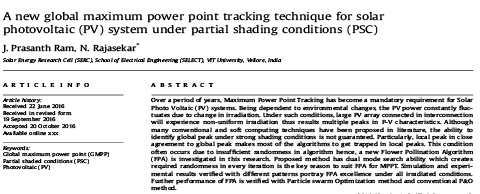Hardware result for 4S-2P- pattern (a) and (b) Similar to simulation. FPA results are verified via hardware prototype under similar operating condition for the following patterns (a). (b). (c) and (d). Experimental results for pattern (a) and (b) with FPA. PSO and P&.O methods are shown in Fig. 16 and Fig. 17. PV simulator is coded with shell SM55 data to match the characteristics with original panel. Compared to PSO and P&.O methods. FPA is the fastest method to converge in shortest time for both the patterns. Further in both the cases FPA has reached GMPP comprehensively with fewer transients at the duty of 0.80 and 0.67. In case of PSO method. its ability to converge at GMPP is clearly visible but the time taken to converge and oscillations are high. Though P&.O method converged to GMPP for pattern (a). it is trapped to one of the local peaks for pattern (b). Moreover. the traditional three point behavior is clearly seen in both the waveforms.
Energy saving and income generation
Tracking Maximum Power Point is a key tool to extract available maximum energy however. energy saving and income generated via tracking will decide the viability of the method before selection. Hence. the authors performed a performance analysis for the proposed algorithm on a real time conditions with 2.1 KW PV systems located at Technology Towers building of VIT University. With eight 250 W PV panel connected in a string. maximum deliverable output by the system is estimated as 2.1 KW. Since the system with shaded conditions are more complex and challenging in tracking. different PV pattern that occurs often in a day due to cloud passage and building shadows are considered for energy saving evaluation. It is noteworthy to mention that. tracking speed and efficiency are the key parameters that influence the amount of energy saved and income generated. To validate the evaluation on energy savings PSO and P&.O algorithms are also executed in real time conditions and the results are compared. Over a month the irradiation profile in vellore is kept under observation to estimate the effective sun hours and it is found that. the tropical regions in vellore have feasible sunlight for solar power generation between 10 a.m and 5 p.m. Further. for analysis seven different patterns occurring in a day at random intervals is considered and their irradiation profile data is tabulated in Table 5. To verify the performance of algorithm under multiple peak occurrences. P-V curves for all the PV patterns considered under study are simulated using MATLAB and plotted in Fig. 21. With each PV pattern running for an hour. the convergence to global peak for PSO. P&.O and FPA is closely watched. Power. Voltage and current at MPP are monitored and tabulated for veri- fication. Irrespective of multiple peak occurrences. it is observed that FPA in all the cases has climbed to global peak and assures it supreme robustness over all climatic changes. Whereas PSO and P&.O have delivered less power output when compared to FPA. Notably. for pattern 3 and 4 the PSO method has produced less power since PSO have got trapped in local peaks. In case of P&.O method. except pattern 6. in all other cases it is trapped under local peaks. Hence. the algorithm performance studied with different patterns are quantitatively compared and compiled in Table 6. Based on the critical analysis performed with 7 different patterns. a summary on amount of revenue generation. cumulative energy generation for ESH for a day is estimated and included in Table 7. To show the importance of income generation relying on energy saving. units generated via all the methods is scaled for a year in which. FPA yet again proved its quality as promising alternative in MPPT implementation. From both simulation and hardware analysis performed earlier section and in energy saving. it is observed that dual search process in FPA with reduced complexity is the key success for its suitability for tracking. Further various results obtained in this section are clearly quantified in bar chart as presented in Fig. 22. From the figure. it is seen that except tracking speed. FPA has excelled to stand tall in all the other criteria considered for energy evaluation. Since P&.O have a short coming of trapping under local power peaks. it attains faster convergence superior to FPA. However. the power generated via P&.O is always less when compared to FPA. Thus the discussion clarifies that FPA has emerged to be a finest alternatives to conventional and swarm optimization methods.
 Iran Energy News Oil, Gas, Petrochemical and Energy Field Specialized Channel
Iran Energy News Oil, Gas, Petrochemical and Energy Field Specialized Channel




